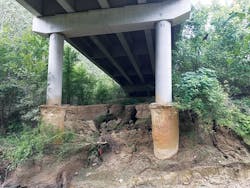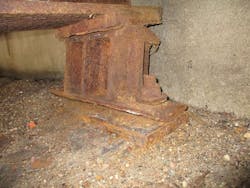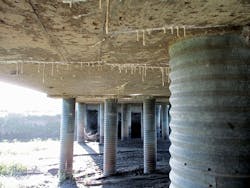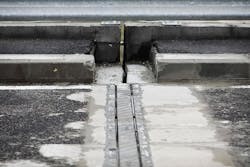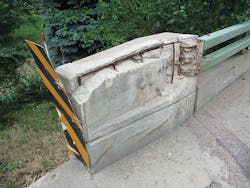Fixing America’s Bridges on a Shoestring Budget
It’s no secret: America’s bridges are aging dramatically and need to be urgently maintained or completely replaced to prevent disruptions to commercial trucking and the traveling public.
But with limited budgets, what can city, county, and state transportation officials do to maintain their bridges while operating with already thin budgets stretched even thinner because of the COVID-19 pandemic and the reduction in traffic-based revenue that has resulted from it?
According to the American Society of Civil Engineers (ASCE), “there are more than 617,000 bridges across the United States. Of these, 42% of all bridges are at least 50 years old, and 46,154, or 7.5% of the nation’s bridges, are considered structurally deficient, meaning they are in ‘poor’ condition.”
Despite this, the rate of improvement for our nation’s bridges is slowing. At the current rate of investment, the ASCE has estimated that it could take 50 years to make all of the current repairs that are necessary to achieve an overall state of good repair, while keeping up with all of the deterioration that will take place over that same time frame. Needless to say, the cost to repair America’s bridges runs into the tens of billions of dollars. Even if the Biden Administration’s $2 trillion infrastructure proposal is passed by Congress, it is likely that only a fraction of those funds will go to bridge maintenance, considering the numerous other critical infrastructure projects vying for funding as well as the added focus on forward-thinking categorical investment in areas not traditionally considered to be “infrastructure.”
So, knowing the constraints that local, county, state, and federal governments face in finding the money to improve America’s bridges, what can be done to get more life out of the bridges we have? Based on my experience as a bridge designer, engineer, and inspector, here are eight items worthy of consideration:
Set up a Prioritization System: No two bridges are alike. Age alone is not the number one factor in prioritizing which bridge gets help first. Look at the Brooklyn Bridge—even though it opened in 1883, because of its iconic nature, maintenance has been a priority. This bridge continues to service over 100,000 vehicles each day. Focus on consistent preventative maintenance to avoid the need for major rehabilitation.
Take a Wholistic Approach: When you have a bridge inspected, make sure your inspection team looks beyond the details, such as the bridge joints or the condition of the bridge deck. Step back to take a look at the entire structure. Do you notice a change in geometry? Do you see changes in how the bridge is being used or the amount of traffic going over the bridge? Factor in the health of the bridge in its entirety into your assessment and planning.
Prevent Small Problems from Becoming Big Problems: The biggest problem we have in our country when it comes to bridge maintenance is that small problems are often put off until there are enough accumulated issues to justify hiring a contractor to do all of the fixes at one time. To get more life out of your bridges, break out of that pattern and instead start to make all of the small fixes as they are spotted. Consider grouping a number of bridges under one contract to handle such small repairs versus contracting out for each bridge.
Focus on Bridge Joints: The bridge joint is the interface between the road and the bridge, and it should be at the top of the list for preventative maintenance. Many older bridges incorporated a strip seal of some form to waterproof for the joint. Some bridges lack this joint sealant all together, creating an opening for moisture and debris to accumulate on the bearing seat. Installing and maintaining the joint seal is a low-cost way of avoiding bigger problems in the future and a good way to extend the life of your bridge. Watch for tearing in the seal and make sure to regularly clear objects that could tear into the seal, such as bolts, screws, nails, wood, and even discarded coffee cups and vaping cartridges, which some drivers still consider OK to toss from their vehicles while out on the road. Pay special attention to bridges in high traffic areas where it is more likely road debris will get into the joint.
Replace or Eliminate the Joints: At some point, through a combination of wear and tear along with routine aging, you will need to completely replace the seal. As much as possible, replace joints before they have completely failed to protect the superstructure and substructure below. When it comes to replacements or major rehabilitations, move the bridge joints off the bridge to eliminate the need for future costly maintenance. One solution could be the use of an integral abutment, moving the joint to the end of the approach slab.
Turn Up the Road Sweeper: One of the lowest cost, most effective things you can do to maintain bridge life is to regularly use a road sweeper to clean off your bridges. Removing dirt, sand, rocks, road salt, and objects such as nails, screws, glass, and other items prevents ponding of water that could damage bridge joints. Water is the number one enemy of bridges and allowing it to flow as intended will improve the structure’s service life. Instead of once a year, consider doubling or tripling your bridge cleaning efforts. It is a relatively low-cost method to achieve high return on service life.
Install Remote Water Gauges: One of the most common causes of catastrophic bridge failures is scour, where water removes the soil supporting a bridge’s foundation. Typically, this is a known issue well in advance of the failure, as identified in biennial inspection reports. Consider installing remotely monitored gauges to measure water levels and water flow, which will give you an indication of when bridges are experiencing higher flow events. This can be used as a part of a scour plan of action to trigger an off-cycle bridge inspection to ensure the foundation has not been compromised during the flood event. This is especially important if bridges are located in floodplains and subject to an increasing number of flooding events, as is common, for example, in parts of the Upper Midwest.
Get Away from Deicing Salts: Salt-based deicing chemicals are highly effective at melting ice, but they are also highly corrosive to steel and leach through concrete, accelerating the deterioration of the bridge superstructure. Consider switching to sand or magnesium chloride, which are more environmentally friendly and still effective.
Avoid Adding Excessive Dead Load: Excessive amounts of asphalt impose a dead load on the bridge, which will negatively impact the bridges load rating. I have seen locations where enough asphalt has been added that the bridge requires load posting. Consider milling the asphalt surface prior to placing an overlay in locations where the additional dead load would be detrimental to the load rating. Thin overlays in place of more traditional lift thicknesses are also an option.
While I geek out on bridges, I know for most of the world bridges are unglamorous, so it is hard for governments to make them a priority when there are so many other pressing needs all gathering at once. However, as we look toward the future, the reality is that there will still be, relative to general need, a dearth of funding for bridge replacement and maintenance. At the same time, we are likely to see more accelerating deterioration of our existing bridges with more vehicle traffic from growing populations in urban/suburban areas and a rise in severe weather events.
Like the old saying goes, I think the best way to get more life out of our bridges is to invest in an ounce of prevention today to avoid the expense of a much more costly cure tomorrow.
